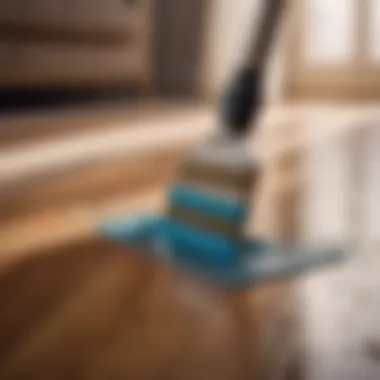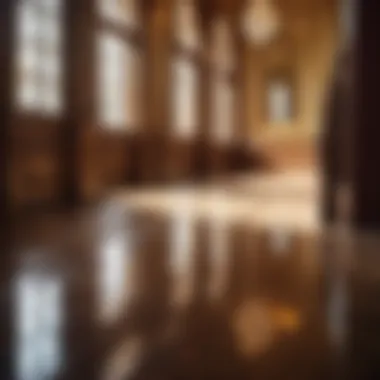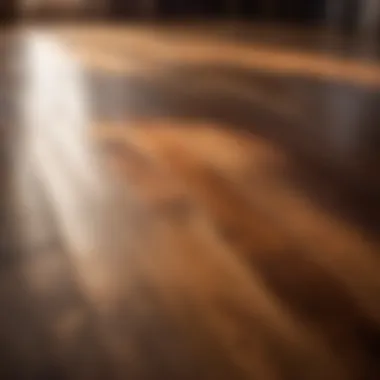Materials:
- Sandpaper (80, 120, and 220 grit)
- Paint scraper
- Tack cloth
- Paint stripper
- Protective gear (gloves, goggles, mask)
- Machinery (floor sander, buffer)
DIY Steps:
- Start the varnish removal process by sanding the floor with 80 grit sandpaper, focusing on removing the top layers.
- Use a paint scraper to eliminate stubborn varnish spots in tricky areas.
- Wipe the floor with a tack cloth to remove any debris or dust particles.
- Apply a generous amount of paint stripper following the manufacturer's instructions.
- Allow the paint stripper to work its magic on the varnish layers.
- Utilize a floor sander with 120 grit sandpaper for a more thorough varnish removal.
- Follow up with a buffer using 220 grit sandpaper to smoothen the floor surface.
Technical Aspects:
- Sanding techniques: Use consistent pressure and smooth movements for even varnish removal.
- Timing specifics: Allow sufficient drying time between each step to ensure effective varnish eradication.
- Critical techniques: Feather edges while sanding to prevent uneven surface textures.
DIY Project Process:


- Start by preparing the materials and ensuring proper ventilation in the work area.
- Begin sanding in one corner of the room and systematically work your way across the floor.
- Monitor the floor’s progress and adjust sandpaper grit accordingly for optimal results.
Troubleshooting Tips:


- If the varnish is not lifting, reapply the paint stripper and leave it for a longer duration before resuming sanding.
- In case of uneven sanding marks, switch to a higher grit sandpaper gradually to smoothen out the surface.
- Address any discoloration or imperfections by applying a finishing layer or spot treatments as needed.
Introduction


In the realm of home improvement and restoration, the process of removing floor varnish stands as a fundamental aspect that significantly impacts the overall aesthetic and longevity of your flooring. Welcome to the gateway of this comprehensive guide, where we delve deep into the intricate world of floor varnish removal, equipping you with knowledge and expertise to undertake this transformational journey with confidence and proficiency.
As we embark on this insightful exploration, the importance of understanding the nuances of floor varnish removal cannot be overstated. Whether you are a seasoned DIY enthusiast or a homeowner looking to revitalize your living space, grasping the essentials of varnish removal sets the stage for a successful project outcome. By unraveling the layers of information encapsulated within this guide, you will gain insights that extend far beyond mere surface-level renovation.
Delve into the specific elements that underline the significance of these insights. From the initial stage of assessing your floor's varnished surface to the final touches of enjoying the fruits of your labor, each segment of this guide holds invaluable wisdom tailored to elevate your restoration endeavor. Embrace the benefits of meticulous planning, strategic tool selection, and methodical execution, all aimed at empowering you to achieve professional-grade results right in the comfort of your home.
As we navigate through the complexities of floor varnish removal, considerations such as safety protocols, environmental impact, and cost efficiency will be meticulously addressed to ensure a holistic approach to your project. By immersing yourself in the wealth of knowledge presented within these digital pages, you pave the way for a seamless and rewarding experience, transcending the realm of mere DIY tasks into a satisfying journey of craftsmanship and transformation.
Understanding Floor Varnish
In this comprehensive guide to removing floor varnish, understanding the nature of floor varnish holds paramount importance. Floor varnish serves as a protective layer applied to wooden floors to enhance durability and aesthetics. By delving into the intricacies of floor varnish, homeowners gain profound insights into the composition, function, and significance of this crucial element in floor maintenance. Understanding floor varnish equips individuals with the knowledge required to select appropriate removal methods and ensure an effective restoration process.
What is Floor Varnish?
Floor varnish, a vital component in the upkeep of wooden floors, is a transparent or colored finish that safeguards the wood from wear and tear, moisture, and stains. Comprised of resins, drying oils, and solvents, floor varnish forms a tough protective coat that enhances the beauty and longevity of wooden surfaces. Its smooth application creates a glossy or matte finish, depending on the desired aesthetic. Recognizing the properties and functions of floor varnish paves the way for informed decision-making in floor restoration projects.
Types of Floor Varnish
Various types of floor varnishes exist, each tailored to different needs and preferences. Polyurethane varnish, known for its durability and water resistance, is a popular choice for high-traffic areas. Acrylic varnish offers a quick-drying, low-odor option suitable for interior surfaces. Shellac varnish, derived from natural resins, imparts a warm, traditional finish to wooden floors. Understanding the distinctions between these types of varnishes allows homeowners to choose the most suitable option based on factors such as desired durability, ease of application, and aesthetic preferences.
Preparing for Varnish Removal
In the process of restoring a floor by removing varnish, the stage of preparing for varnish removal is critical. This stage sets the foundation for a successful outcome by ensuring that the subsequent varnish removal methods can be executed effectively. Preparing for varnish removal entails several key elements that should be carefully considered and implemented.
One of the primary focuses of preparing for varnish removal is assessing the current state of the floor surface. Understanding the condition of the floor, including any existing damage, uneven areas, or imperfections, is essential for planning the varnish removal strategy. By assessing the floor surface thoroughly, homeowners can identify potential challenges that may arise during the varnish removal process, allowing them to take preemptive measures and choose suitable removal techniques.
Moreover, gathering the necessary tools is another crucial aspect of preparing for varnish removal. Different varnish removal methods require specific tools and equipment to be executed efficiently. From chemical stripping agents to sanding tools and protective gear, having the right set of tools ready before initiating the removal process is imperative. By gathering the necessary tools in advance, homeowners can streamline the varnish removal workflow, minimize disruptions, and ensure safety throughout the operation.
Overall, preparing for varnish removal plays a significant role in the overall success of the floor restoration project. By assessing the floor surface meticulously and gathering the essential tools beforehand, homeowners can embark on the varnish removal process with confidence, knowing that they have laid a solid groundwork for achieving a flawless finish.
*Methods of Removing Floor Varnish
The section on Methods of Removing Floor Varnish is pivotal within the context of this comprehensive guide. It serves as the core component where readers delve into the various techniques essential for effectively eliminating floor varnish. Each method brings its own set of benefits, considerations, and specific applications, allowing individuals to choose the most suitable approach based on their unique requirements and the condition of their floors.
*Chemical Stripping
Chemical stripping is a widely used method in the process of removing floor varnish. It involves the application of specialized chemical solutions that work to break down the varnish layers, making it easier to scrape off or wipe away. One of the key advantages of chemical stripping is its ability to penetrate deep into the layers of varnish, ensuring a thorough removal process. However, it is essential to exercise caution and follow all safety precautions when using these chemicals to protect both yourself and the flooring material. Additionally, ventilation is crucial to disperse fumes and maintain a safe working environment.
*Sanding Techniques
Sanding techniques offer a mechanical approach to varnish removal. By utilizing sandpaper or a sanding machine, individuals can effectively sand away the varnish layer by layer, revealing the natural beauty of the underlying wood. This method is particularly suitable for thicker varnish coatings or uneven surfaces where chemical stripping may be less effective. Sanding requires precision and patience to avoid damaging the wood surface, making it essential to start with coarse sandpaper and gradually move to finer grits for a smooth finish. Dust control is imperative during sanding to prevent respiratory issues and maintain a clean work area.
*Heat Stripping
Heat stripping is a technique that involves using heat guns or infrared devices to soften the varnish, allowing for easier removal. This method is popular for its efficiency in quickly loosening the varnish layers without the need for harsh chemicals. Heat stripping can be advantageous for intricate details or hard-to-reach areas on the floor where other methods may be challenging to apply. However, it requires careful monitoring of temperature and distance to prevent scorching the wood or causing fire hazards. Proper protective gear and fire safety measures should be adhered to when employing heat stripping as a varnish removal technique.
Step-by-Step Varnish Removal Process
In the realm of floor varnish removal, the step-by-step process holds immense significance within this comprehensive guide. It serves as the quintessential roadmap for enthusiasts embarking on a journey to revitalize their floors. The meticulous execution of each step guarantees a successful outcome, ensuring that no detail is overlooked in the pursuit of a perfectly restored floor.
Throughout this process, attention to detail is paramount. Understanding the sequence of steps and the rationale behind them is crucial. From preparation to the finishing touches, each phase plays a crucial role in the overall efficacy of the varnish removal endeavor.
One of the primary benefits of following a structured step-by-step approach is the systematic nature of the process. It eliminates guesswork and minimizes the chances of errors, resulting in a streamlined and efficient execution. Additionally, a well-defined process empowers individuals to track their progress and stay on course, instilling confidence and ensuring a high-quality outcome.
Moreover, considering the various nuances involved in floor varnish removal, such as surface type, varnish thickness, and environmental factors, the step-by-step approach offers a tailored method for addressing specific challenges. By breaking down the removal process into manageable stages, individuals can tackle each aspect methodically, overcoming obstacles and achieving a meticulous finish.
Overall, the step-by-step varnish removal process encapsulates a harmonious blend of methodical precision and creative problem-solving. It embodies the essence of careful planning, strategic execution, and diligent effort, culminating in the restoration of floors that exude splendor and sophistication.
Preparation
The preparation phase marks the inception of the varnish removal journey, laying the foundation for a successful endeavor. Thorough assessment of the floor surface is essential during this stage, as it provides valuable insights into the condition of the existing varnish and aids in determining the most suitable removal method.
Key considerations during the preparation stage include evaluating the type of floor to be treated, identifying any pre-existing damage, and ensuring the availability of required tools and materials. By conducting a comprehensive assessment, individuals can preemptively address potential challenges and formulate a targeted approach tailored to the specific characteristics of the floor.
Furthermore, gathering the necessary tools plays a pivotal role in streamlining the varnish removal process. From chemical stripping agents to sanding equipment, having the right tools at hand can significantly enhance efficiency and precision. Additionally, ensuring a well-ventilated workspace and implementing safety measures are integral components of the preparatory phase to safeguard against potential risks.
Application of Chosen Method
Once the groundwork is laid during the preparation stage, the application of the chosen varnish removal method takes center stage. Whether opting for chemical stripping, sanding techniques, or heat stripping, the selection of the most appropriate method hinges on factors such as floor type, varnish composition, and personal preference.
Each method carries its own set of advantages and intricacies, necessitating a nuanced understanding for optimal application. Chemical stripping, for instance, offers a quick and effective solution for varnish removal but requires caution due to its potent nature. On the other hand, sanding techniques provide a versatile approach suitable for various floor surfaces, albeit requiring meticulous attention to detail to achieve a smooth finish.
Throughout the application phase, precision and patience are key virtues. Following manufacturer guidelines, applying stripping agents evenly, and maintaining consistent pressure during sanding are fundamental practices that yield professional results. By adhering to best practices and method-specific instructions, individuals can navigate the complexities of varnish removal with finesse and expertise.
Cleaning and Finishing
The culmination of the varnish removal process entails the crucial steps of cleaning and finishing, essential for unveiling the true beauty of refurbished floors. Thorough cleaning post-removal is imperative to remove residues and impurities, ensuring a pristine surface primed for finishing touches.
Cleaning methods may vary depending on the chosen removal technique, with some requiring intensive scrubbing or gentle wiping to achieve desired results. Regardless of the approach, meticulous attention to detail is paramount to eliminate any remnants of varnish or cleaning agents that may compromise the integrity of the newly exposed surface.
Following cleaning, the finishing touches provide the opportunity to breathe new life into the floors. Whether opting for re-varnishing, staining, or polishing, the finishing phase adds a touch of finesse and protection to the revitalized surface. Carefully selecting the appropriate finish, applying it evenly, and allowing adequate drying time are essential steps to ensure a durable and aesthetically pleasing outcome.
In essence, the cleaning and finishing phase embodies the attention to detail and commitment to excellence that characterize a successful varnish removal process. By meticulously executing these final steps, individuals can bask in the glory of their labor, marveling at the transformation of their floors into stunning showcases of craftsmanship and dedication.
Aftercare and Maintenance
After successfully removing floor varnish, it is crucial to focus on aftercare and maintenance to ensure the longevity and beauty of your newly restored floors. This section delves into the essential practices and considerations to protect your investment.
Protecting the Newly Stripped Floors
To maintain the pristine condition of your stripped floors, it is vital to implement protective measures. Utilizing a high-quality sealant or finish is paramount in safeguarding the wood from stains, spills, and wear. Sealants create a barrier that shields the surface while enhancing its overall appearance. Regularly inspecting the floors for any signs of damage or wear and promptly addressing them is key to preserving their beauty.
Implementing furniture pads under heavy items and using rugs or mats in high-traffic areas can mitigate scratches and dents. Avoiding harsh cleaning agents and opting for gentle, wood-friendly cleaners will help maintain the floor's integrity. By following these protective measures, you can enjoy your newly stripped floors for years to come.
Regular Maintenance Tips
Maintaining the appearance and durability of your stripped floors requires consistent care. Regularly vacuuming or sweeping to remove debris prevents scratches and enhances the floor's longevity. Using a damp mop with a mild cleanser designed for wood floors helps to remove dirt and grime effectively.
Periodically checking and reapplying the sealant or finish ensures ongoing protection against moisture and stains. Addressing any spills or stains promptly prevents them from penetrating the wood and causing lasting damage. Additionally, controlling indoor humidity levels through proper ventilation or a humidifier minimizes the risk of warping or cracking.
By incorporating these maintenance practices into your routine, you can preserve the beauty and integrity of your stripped floors, prolonging their lifespan and maintaining a stunning aesthetic in your living space.
Conclusion
The Conclusion of this in-depth guide on Removing Floor Varnish plays a pivotal role in summarizing the key aspects and benefits of the varnish removal process. It serves as a final wrap-up, consolidating all the essential information discussed throughout the preceding sections to provide a comprehensive overview for readers. One of the primary elements emphasized in this conclusion is the importance of proper aftercare and maintenance once the varnish removal process is complete. By showcasing the significance of post-removal care, housewives and homeowners can ensure the longevity and durability of their restored floors. Moreover, the Conclusion delves into the satisfaction and sense of achievement that individuals experience upon seeing the beautifully stripped and refinished floors. This sense of accomplishment not only adds value to the home but also boosts the overall aesthetic appeal, creating a welcoming and cozy ambiance. Furthermore, detailing specific maintenance tips allows readers to proactively protect their newly stripped floors from potential damage and wear, ensuring the investment in varnish removal yields long-lasting results. In essence, the Conclusion encapsulates the essence of the entire varnish removal process, from the initial stages of preparation to the final steps of maintenance and upkeep, empowering readers with the knowledge and confidence to undertake their floor restoration projects successfully.





